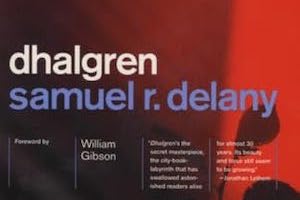Craig Laurance Gidney has been writing queer Black speculative fiction for about two decades now, with two adult short story collections out (Sea, Swallow Me from 2008, and the 2014 Skin Deep Magic) and a young adult novel (Bereft, 2013). He writes primarily dark fantasy, weird fiction and horror, with a finely-crafted literary touch. I have previously read and enjoyed Skin Deep Magic and Bereft, and his most recent work: his chapbook The Nectar of Nightmares was given an ebook release last month. For this installment of the QUILTBAG+ Speculative Classics reviews series, I was happy to go back to his first collection, which was new to me.
A 2008 book also brings us nearer to the present than the titles we’ve previously covered, and almost to the cutoff of 2010. This choice has its own challenges, especially since many of the stories feature contemporary settings. Will this make them more relatable, or just a little bit strange?
Sea, Swallow Me contains ten stories, several of them novelette length. It is clearly a first collection, with Gidney’s newer work feeling more polished—but with a writer who has such a strong handle on his craft, even the first book is a gorgeous read. The stories span almost a decade, from 2001 to 2008. I really enjoyed exploring the previously unpublished pieces, and had to wonder how many of them remained unavailable before this collection because SFF publishing, by and large, has been traditionally unfriendly both to queer and Black authors (especially a decade or more ago).
The stories can primarily be categorized as dark fantasy. I feel the strongest pieces are those that are closest to the present day of the book—for instance, Etiolate is a story about gay clubbing that takes a horrific turn. Oliver, the protagonist is Black and gay and looking to have a good time… but he is faced with his own demons when his one-night stand ends in death. The story presents the early-2000s American club scene in visceral detail:
Centaurs in polyester, elementals in platforms. Like the dryads and nymphs of that imaginary realm, they were oblivious to him. He was here because goth bored him, with its stupid pretension; and gay-only places were fascist, filled with assholes. “Nazi FuckBoys” was what he called them. These New-Age discos, however, had very little baggage. They were clean and relatively good-natured, maybe because of the E people were taking.
Our time perspective in 2018 is, in part, what makes this story chilling.
The present can also reach not only ahead to the future, but also back towards the past. One of my other favorite stories in the book was “Come Join We,” about a boy who starts to see visions of the past after a fever —visions involving the persecution of Black and Native people. This story is not only concerned with understanding history, but also being in the difficult position of being more aware than most, and others’ attempts at suppressing this awareness. It also feels important to me that the origin of the suppressed knowledge is clairvoyant, which reminds us of white supremacist attempts at eradicating spiritual traditions and communities.
There are other elements involving the spiritual woven through the book. The title story features an undersea descent that has parallels with various subversions of Lovecraft and cosmic horror (many of which have been written and published after 2008!), and foreshadows Gidney’s move toward Weird fiction. In “Sea, Swallow Me,” a gay Black man tries to come to terms with his ancestry, which has been presented as alien to him and yet can still become a kind of home.
We also find some straightforwardly (gayforwardly?) historical fantasy stories in the book. The opening story, “The Safety of Thorns,” is set in the time of antebellum slavery, and it solidly anchors the entire collection—just as the final story bookends it. “Catch Him by the Toe” is about a lynching, in a fictionalized American town in the South, where the circus comes to visit. Othering and exclusion are laid bare as we witness the circus and the freakshow, institutions that oppress and caricaturize their own members, who are cast out by the town in turn.
On a slightly lighter note, “Strange Alphabets” follows a classic French poet and his misadventures trying to get to Paris. His train ride involves hiding among suitcases, stealing sweets, and a sexual encounter gone terribly wrong…until he is lucky to come out of the mess alive. (Gidney never seems to give his characters an easy time.)
“A Bird of Ice” also has a historical setting, this time in Japan. A young monk develops an unexpected relationship with a supernatural creature. This story attempts to present the gracefulness associated with Japanese-themed fantasy, but at the same time subverts it to point out its stereotyped nature. The scene where a swan is loose in the kitchen will stay with me. However, I was not always convinced about the handling of the cultural aspects. (As a non-Japanese person, I am also an outsider to this, and thus not the best judge.)
Another odd-one-out in the collection is contemporary in nature: The earliest story in the book, “Circus-Boy Without a Safety Net,” originally published in 2001, has few if any speculative elements – but it presents a gay Black boy’s coming of age in a Christian family with lyricism and striking beauty. I am glad that Gidney writes speculative fiction, but this story shows that he excels in non-speculative work as well.
I did have some issues with the collection, and some of them are due to its age. As several of the stories have near-present-day themes, it makes the reader aware of how terminology has changed in the past decade, and how there is more discourse and awareness about various topics. One example: a gender-nonconforming character goes from he to she to it, with both the character and the author struggling to find the appropriate words. I think all of us QUILTBAG+ writers will feel the same way about our quasi-present-day stories a decade on, and find that we would have phrased things just slightly differently; so I wouldn’t penalize the book, but readers should be aware.
These are generally minor issues, and are not present in Gidney’s more recent work. However, even at the very beginning, there is a general structural awareness of marginalization in these stories that extends well beyond the author and the point-of-view character. To me, this more than makes up for specific line-level difficulties. We do get the sense, for instance, of how white supremacy affects many different ethnoracial groups, and in different ways, even if the specific phrasings involving other groups aren’t always what we would use in the here and now.
These days, Lethe books are always meticulously presented and proofread. (I am biased because they’ve also published me!) This earlier volume has the same beautiful interior presentation, and some truly ethereal cover art, but more typos than more recent titles. The most jarring was seeing the Japanese “Amaterasu” consistently misspelled, but there were also a number of missing articles.
Regardless, this collection is well worth picking up, and Gidney is still very actively writing, so I recommend following his newer work, as well. In our next installment, we will go further back in time and discuss a single-author collection by one of the earliest lesbian SFF writers!














